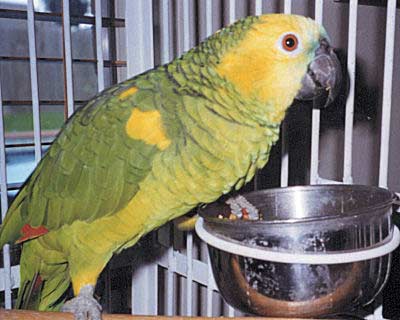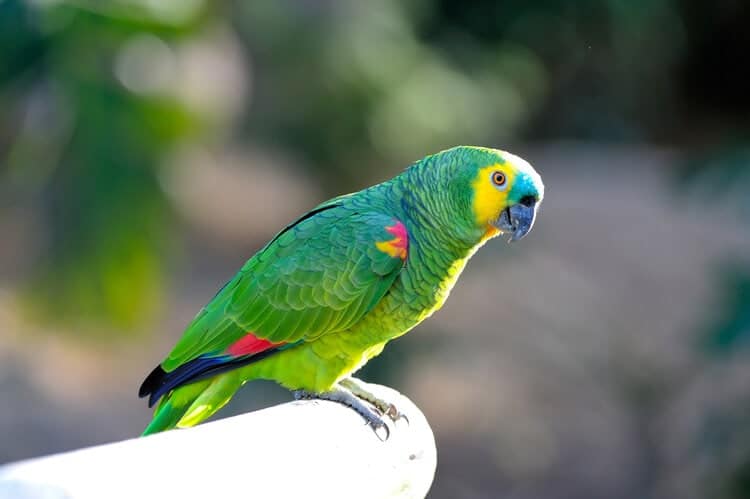
Blue Front Amazon is a very outgoing bird, a great performer and loves to talk!
The Blue-fronted Amazon Parrots Amazona aestiva are very sociable extroverts, they love to showoff. These pretty birds have long been popular as pets and are one of the most commonly kept Amazon species. They are mentioned in literature written well over 100 years ago. It is an attractive bird with vivid coloring as an adult, yet each adult will have its own feathering pattern. It is known to have one of the longest life spans, 40 plus years, with the potential of reaching nearly a century in captivity.
This is an intelligent parrot that can be trained to perform tricks and to talk. Comical and entertaining, the Blue-Front Parrot is a bird that you will frequently see in live animal acts. They love to learn and they even can sing. They definitely love music. They can speak and some Blue-fronted Amazons speak just as well as the yellow Amazon parrots like the Double Yellow-headed Amazon Amazona oratrix, or the Yellow-crowned Amazon Amazona ochrocephala.
The Blue-Front Amazon can be quite independent, but it is one of the easier going Amazons. It will probably have a favorite in the family, however will normally consider the entire family to be part of its flock and behave accordingly. Yet it can become quite attached to one person and if it is not socialized well, will frequently dive bomb anything it feels is a threat to its human. In general all Amazons can be quite protective of their human counterparts. It is important to socialize this parrot starting at a young age.
This is a calmer amazon and fun to watch. Blue-fronted Amazons like interaction but are quite content to entertain themselves for hours at a time just playing with their toys. The Blue-Front gets along quite well with other birds. It is usually non-aggressive although the males might get a little territorial during breeding season or molting.
For more information about Amazon Birds see:
Amazon Parrot: Information and Care
- Kingdom: Animalia
- Phylum: Chordata
- Class: Aves
- Order: Psittaciformes
- Family: Psittacidae
- Genus: Amazona
- Species: aestiva
Scientific name
Amazona aestiva
Distribution
The Blue-fronted Amazon Amazona aestiva was first described by Linnaeus in 1758. It is also known as the Blue Front Parrot and Turquoise-fronted Amazon. It is native to Bolivia, Brazil, Paraguay and Northern Argentina. In the wild they live in flocks. They inhabit forests and wooded areas where they feed on fruits, berries, seeds, nuts, and the blossoms and leafy buds of foliage.
Status
The Amazona aestiva is on the IUCN Red List for Endangered Species as Least Concern (LC).
Description
The Blue-fronted Amazon is similar to the Orange-winged Amazon Amazona amazonica, but is larger overall. The Blue-Front is primarily green, however, there is quite a bit of color to this species. The feathers are edged with a dusky black. Directly above the upper mandible are blue feathers, going into white and then yellow. The yellow feathers can wrap around the head, eyes and neck. The feet and beak are gray. These birds can reach up to 14″ (36 cm).
There is considerable variation in the markings and coloration on the Blue-Front. Sometimes the blue is a vivid turquoise, thus the name Turquoise-fronted Amazon. Sometimes the blue will cover the entire face. The wings, when extended, will show vivid colors of bright red and violet blue. There are also several mutations of the Blue-Front, but the mutations are not readily available in the pet market.
- Lutino – There is a Lutino mutation where the bright yellow feathers are replaced with white.
- Cinnamon – The Cinnamon mutation is a cinnamon-yellowish color.
- Blue – Another mutation produces an all blue bird with pale yellow markings.
Care and feeding
In the wild, the diet of the Blue-front parrots consists of fruits, plants, seeds and nuts and probably some protein. A pet bird will enjoy a varied diet, including a quality seed mix or a pelleted diet, and many fresh fruits and vegetables. Plenty of human food that is nutritious can be offered, and they like chicken. Avocado and chocolate are toxic to any parrot. They like to eat at the table and enjoy eating with their family. They will let you know when it’s dinner time.
Housing
A roomy cage is required for the Blue-fronted Amazons. Amazon parrot cages must not be too confining, so get one that your pet will be able to feel comfortable in. It is their territory and their safe place.This parrot likes to climb and play, and enjoys expanding its wings. It is recommended that a cage be 2 x 3 feet wide and 2 1/2 to 5 feet high, and with a play pen top. A great thing is to have a hanging perch above that for climbing.
Blue Front Parrots can tolerate varying temperatures, but they need to be kept away from any drafts. They love to be out of their cage on a playpen, and will enjoy interacting with their human as well as playing with toys. A variety of perches should be used of varying size and texture. A rougher textured perch instead of the smooth, doll-rod types, makes it easier for them to perch and is better for their feet and legs. A concrete perch can be placed as the highest perch in the cage and next to a toy. At times during the day they will perch there and it will save them (and you) from the ordeal of having their nails filed.
Learn to have fun during bath time. Whether you spritz your amazon with water or an aloe spritz, or just put him in the kitchen sink, make it fun. Your amazon will teach you how he likes to be bathed.
Maintenance
The basic cage care includes daily cleaning of the water and food dishes. Weekly you should wash all the perches and dirty toys, and the floor should be washed about every other week. A total hosing down and disinfecting of an aviary should be done yearly, replacing anything that needs to be freshened, such as old dishes, toys and perches.
Social Behaviors
These parrots enjoy human interaction as well as interaction with other birds. They like to be greeted when you come into the room. They like to eat at the table and will let you know when it’s dinner time. They are quite content and comfortable to be on a perch and in the company of its humans. Whether watching TV or eating dinner, the Blue-Front wants to be with you. The more your amazon is around its human counterparts, the more socialized it is and the more it will talk, sing and mimic. You will establish a greater attachment between you and your feathered friend the more you are together.
Handling/Training
The Blue-fronted Amazon quickly becomes accustomed to a new environment and its keeper, and is then ready to start bird training. Generally though, you should give a new arrival a few days to get use to you, your voice and its cage before trying to handle it. A hand fed baby will not need much taming and can often be handled right away, as it is use to human attention.
For information about training your Blue Front parrot see: Amazon Parrot Care: Handling and Training
Activities
The Blue-Front is an active amazon and needs plenty of toys, and a hanging perch would be great. A moveable perch that can follow you around the house is almost a requirement. It likes to play, will make its own music and dance, and is quite an acrobat. They entertain themselves quite well and you will enjoy it.
WBA_P76_med.jpg) Baby Blue-fronted Amazon Photo © Animal-World: Courtesy David Brough
Baby Blue-fronted Amazon Photo © Animal-World: Courtesy David BroughSexing – Sexual Differences
Blue-fronted Amazons are not sexually dimorphic, females look like males. If gender identification is important (for example for breeding birds) DNA / Feather or surgical sexing is recommended.
Breeding/Reproduction
These Amazons are commonly bred in captivity. But the sexes must be confirmed and the pair must be harmonious, bonded with each other.
They will need a nest box that is 31″-39″ (80-100 cm) high with an inside diameter of 12″-14″ (30-35 cm) and an opening of 4″-5″ (10-12 cm). Provide some soft bedding material inside on the bottom of the box.
The hen will lay two to four eggs (sometimes 5) which she will incubate for about 29 days. The young will leave the nest at proximately 9 weeks old. In some cases the female will not feed all the chicks so a breeder will be feeding some from day one.
Potential Problems
The Blue-fronted Amazon, though a quieter amazon, can be noisy early in the morning and when the sun is setting. This usually lasts for about 10 minutes. It is just waking up and letting you know it is up or getting ready for bed. These parrots when well cared for will seldom become ill. Though it is often difficult to determine illness, some visible signs of illness to be aware of are:
- ruffled plumage
- listlessness
- drooping wings
- sagging body
- extreme mood changes
- having no appetite
- bulges in feathering
- partially closed or watery eyes
- swelling of the eyelids
- rasping
- difficulty breathing
- excessive saliva
- dirty vent
- any change in the feces not apparently diet related.
Some of the more common illnesses are:
- Psittacosis (chlamydiosis or parrot fever)
- bacterial, viral, or fungal infections
- feather picking (results of boredom, poor diet, sexual frustration, lack of bathing)
- allergies
- chewing flight and tail feathers by juveniles
- beak malformations in chicks
- Papillomas
- kidney disease (gout)
- toxicity
- heavy metal poisoning
- lipomas in older birds.
If you notice any of these bird illnesses in your Blue Front parrot, immediately provide a warm, draft free, secure environment kept at about 86°F (30°C). Place food and water close to the perch where it is easily accessible. An ailing parrot should be taken to a avian veterinarian for diagnosis and treatment.
Availability
Blue-fronted Amazon Parrots are readily available and it should be easy to find one in a pet store or from breeders in your area..
References
- Animal-World References: Pet Birds – Exotic Birds
- Dr. David Alderton, The Atlas of Parrots of the World, T.F.H. Publications, Inc. 1991
- David Alderton, Parrots, Salamander Books, 1999
- David Alderton,, A Bird Keeper’s Guide to Parrots and Macaws, Salamander Books, 1989
- Arthur Freud, All About The Parrots, Howell Book House, 1986
- Werner and Susanne Lantermann, Amazon Parrots, Barron’s Educational Series, Inc. 1988
- Blue-fronted Yellow-shouldered Amazons, AvianWeb LLC, Copyright 2010
Featured Image Credit: aabeele, Shutterstock
